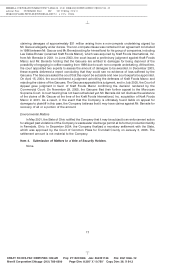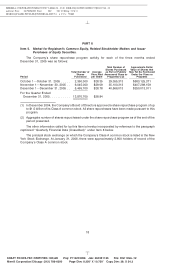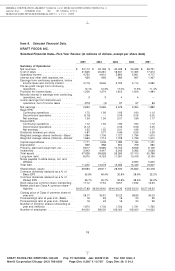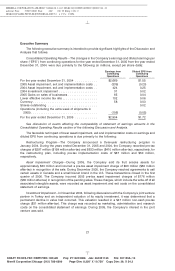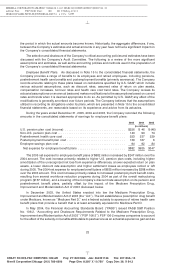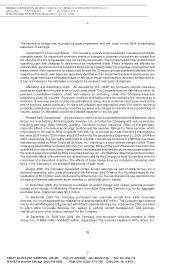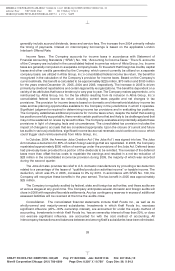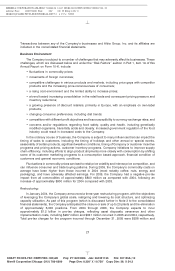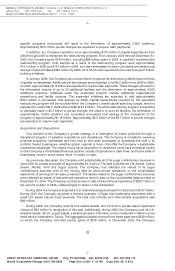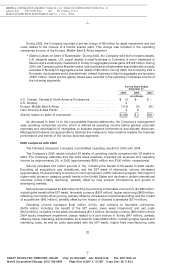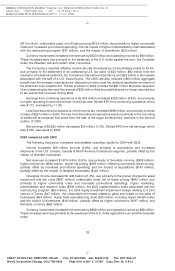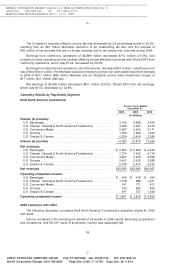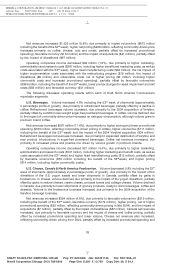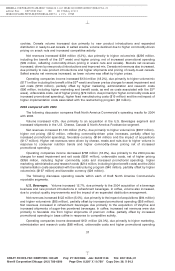Kraft 2005 Annual Report Download - page 28
Download and view the complete annual report
Please find page 28 of the 2005 Kraft annual report below. You can navigate through the pages in the report by either clicking on the pages listed below, or by using the keyword search tool below to find specific information within the annual report.
MERRILL CORPORATION ABLIJDE// 7-MAR-06 14:42 DISK126:[06CHI5.06CHI1135]DI1135A.;10
mrll.fmt Free: 110D*/240D Foot: 0D/ 0D VJ RSeq: 8 Clr: 0
DISK024:[PAGER.PSTYLES]UNIVERSAL.BST;51
KRAFT FOODS-FSC CERTIFIED-10K/AR Proj: P1102CHI06 Job: 06CHI1135 File: DI1135A.;10
Merrill Corporation/Chicago (312) 786-6300 Page Dim: 8.250 X 10.750Copy Dim: 38. X 54.3
Transactions between any of the Company’s businesses and Altria Group, Inc. and its affiliates are
included in the consolidated financial statements.
Business Environment
The Company is subject to a number of challenges that may adversely affect its businesses. These
challenges, which are discussed below and under the ‘‘Risk Factors’’ section in Part 1, Item 1A of this
Annual Report on Form 10-K, include:
• fluctuations in commodity prices;
• movements of foreign currencies;
• competitive challenges in various products and markets, including price gaps with competitor
products and the increasing price-consciousness of consumers;
• a rising cost environment and the limited ability to increase prices;
• a trend toward increasing consolidation in the retail trade and consequent pricing pressure and
inventory reductions;
• a growing presence of discount retailers, primarily in Europe, with an emphasis on own-label
products;
• changing consumer preferences, including diet trends;
• competitors with different profit objectives and less susceptibility to currency exchange rates; and
• concerns and/or regulations regarding food safety, quality and health, including genetically
modified organisms, trans-fatty acids and obesity. Increased government regulation of the food
industry could result in increased costs to the Company.
In the ordinary course of business, the Company is subject to many influences that can impact the
timing of sales to customers, including the timing of holidays and other annual or special events,
seasonality of certain products, significant weather conditions, timing of Company or customer incentive
programs and pricing actions, customer inventory programs, Company initiatives to improve supply
chain efficiency, including efforts to align product shipments more closely with consumption by shifting
some of its customer marketing programs to a consumption based approach, financial condition of
customers and general economic conditions.
Fluctuations in commodity prices can lead to retail price volatility and intense price competition, and
can influence consumer and trade buying patterns. During 2005, the Company’s commodity costs on
average have been higher than those incurred in 2004 (most notably coffee, nuts, energy and
packaging), and have adversely affected earnings. For 2005, the Company had a negative pre-tax
impact from all commodities of approximately $800 million as compared with 2004, following an
increase of approximately $900 million for 2004 compared with 2003.
Restructuring:
In January 2004, the Company announced a three-year restructuring program, with the objectives
of leveraging the Company’s global scale, realigning and lowering its cost structure, and optimizing
capacity utilization. As part of this program (which is discussed further in Note 3 to the consolidated
financial statements), the Company anticipated the closure or sale of up to 20 plants and the elimination
of approximately 6,000 positions. From 2004 through 2006, the Company expects to incur
approximately $1.2 billion in pre-tax charges, reflecting asset disposals, severance and other
implementation costs, including $297 million and $641 million incurred in 2005 and 2004, respectively.
Total pre-tax charges for the program incurred through December 31, 2005 were $938 million and
27
6 C Cs: 52013


